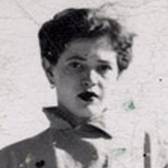
-
Learn More about Ruth
- Collections View Ruth's family papers and photographs
- Echoes of Memory Read Ruth's writings
- Oral History Access Ruth's Oral Testimony
Ruth Cohen was born on April 26, 1930 to Herman and Bertha Friedman in Mukačevo, Czechoslovakia. Herman and his brother were wholesale wine and beer manufacturers. Ruth, her older sister, Teresa, and younger brother, Aharon, often helped to fill bottles on Friday evenings before the Sabbath. The Friedmans were Orthodox Jews as well as Zionists and Ruth and her siblings were sent to the Hebrew Gymnasium, a school where the curriculum was taught entirely in Hebrew.
In 1938-1939, Nazi Germany dismantled Czechoslovakia. In 1938, Mukačevo (Munkács in Hungarian) and other surrounding towns became part of neighboring Hungary, an ally of Germany. Hungarian anti-Jewish laws put restrictions on the country’s Jews. Ruth’s father could no longer run his own business, but was able to continue to work for the company. Despite growing restrictions, the Friedmans were able to adopt two of Ruth’s cousins who had been sent to live with them from Slovakia, where Jews were being deported to killing centers. In 1942, Ruth’s mother learned that some of her family in Slovakia had been taken to Lublin/Majdanek.
In March 1944, Nazi Germany invaded and occupied Hungary. In April, Ruth and her family were forced from their home and into a designated ghetto. The following month, Ruth, her family, and others living in the ghetto were marched by German soldiers to a local brick factory and told to board the freight cars waiting there. As Ruth was getting on, she watched as a favorite school teacher was shot and killed for refusing to follow orders. The freight cars arrived at Auschwitz-Birkenau killing center four days later. Ruth and her sister Teresa were able to stay together, but they were separated from the rest of their family. Although she did not know it at the time, Ruth's mother, brother, and cousins were sent to the gas chambers, while her father was selected for labor. Ruth and her sister arrived at their assigned barracks where they were approached by a woman named Miriam Leitner who remembered Teresa from summer camp. Miriam was the director of the barracks and was able to secure jobs for the sisters; Teresa as her assistant and Ruth to deliver messages throughout the camp.
In late October 1944, after a failed uprising and the destruction of an Auschwitz crematorium, Ruth and her sister were sent in a transport to a concentration camp in Nuremberg, Germany. Although Ruth was very sick by this time, she was still able to do the work assigned to her. By February 1945, the camp was destroyed from constant bombing. Ruth and Teresa were sent to Holleischen, a subcamp of Flossenbürg concentration camp. They worked in a factory that manufactured airplane parts. Conditions here were better than in the other camps. Three months later, Ruth and Teresa were liberated.
Ruth and Teresa made their way back to their hometown where they reunited with their father. After she spent a year recovering in a hospital, Ruth and Herman immigrated to the United States on April 24, 1948 and Teresa followed six months later. The family settled in New York City where Ruth found a job as a cashier for the Education Alliance. She met Benjamin Cohen there and married him in 1952. They have three children. Today Ruth lives in the Washington, DC area and is a volunteer at the United States Holocaust Memorial Museum.
